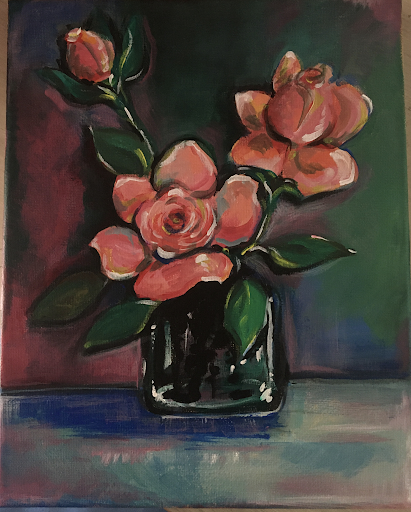|
A dynamic truth! A fair judgment to be done! And just another level of stupidity! In fact, it's an indirect one… The time we spend on things we love is way too little than the time we spend on social media. Oooh no! Let me check what Peter has posted this week on Instagram. Or perhaps, it will be so cool and so nice to check on what Mary posted on Tik Tok… But, time still counts, “Tick tock tick tock" And death comes like Boom! We then become addicted to our so-called social life partners. Old days seem more astonishing than the current days… Just to be more precise, the difficulties in doing things made people intelligent and hardworking. But, right now right here, you light up a house with one click on the switch then on it goes! The lights! Such a thing, demanded several trials on a log rubbed smoothly but roughly just to create fire. Sounds interesting right? But, what do we learn from the many trial and errors that gave us a lesson every single time? It actually gave our elders the ability not to give up. It actually made them understand that the world was full of trial and errors which later led to better infrastructures like The Egyptian Pyramids. But come on… wait first! What was Elon Musk's latest post on his newly bought-possession Twitter? Ooh no! Why am I still obsessed with what I am just criticizing? I don't know for real… To be honest, I have had this experience where we are just bonded or perhaps married to a wife or husband named “Social Media” with a full-amazing-gold ring. This might sound harsh but it's actually a truth we have to tolerate. The life principle, which I actually don't know about, tells us that the only people we will be bonded to a lot are our life partners. Ha ha, just kidding! The depth of its effect is far higher than the depth of its advantages which leaves us with an understanding that probably we might be expecting divorces from our life partners. That is what will happen when social media platforms get banished due to the effects it will have caused. We might find ourselves in a drastic confusion of what to do after getting the divorce from these social media platforms. A question just popped up in my mind, actually it's a question I have seen before, which says "What would you do when the internet gets off to replace the time you spend on it?" Huh? Is this a stupid joke or just a mere example of how the crazy people prank the intelligent people? You know, it's actually a thought from someone who might be crazy or just insane enough to speak such bullshit. But, the reality remains that these kinds of people are the most intelligent ones because they realize the depth of the disadvantage. They realize that these platforms which tend to connect people are the same platforms which destroy the role of humanity on earth. Just a simple question, how many people feel absolutely comfortable speaking with people physically than online? Probably very few… But why? It's mainly due to the drastic push we get from our so-called "Life Partners" or let's just say "Destructive Life Partners" named Social Media. Boom! So this is what I have learnt from the Social Media platforms: Well, like lightning it strikes and brings terrifying effects on earth through the breaking rumors it gives out. Like sun rays it gives us the pretendence-like heat unless the ozone layer is tempered through fake-true news it offers. We still survive knowing that we have more to face but unlikely knowing its effects. We live, we survive and we still spend time with our so-called-partners named Social Media. Did I just say something about time? Ooooh no! Wooohooo! Here comes the worst part! Just relax ok? I took time and spared some to check my screen time. I was puzzled and actually surprised with what I saw. Like seriously!!! Did I just spend 6 hours only on Instagram? Ooh come one! Was I stupid to spend 7 hours on ticktock? Mmmh! This sounds fun but how come more than half of my day is just spent on social media? It's magic right? Huh? Still sounds sarcastic… Anyway, let me check what Elon has posted on Twitter this time. Ladies and gents, or let's say online-addicted ladies and gents, I have learnt that the physical contact we spend with our physical friends is far too little than the enormous-high-quality-comfortable time we spend on social media. And actually, my imagination leads me to thinking that we might make a movement on Heaven just to be spared some minutes to check out on our friends in hell and at least check their progress. Just kidding though, the reality is, we really need to look at the future we are destined to go through and at least think if our so-called-life-partners will be advantageous to that destiny. Are we really ready to sacrifice our futures just to waste time on our so-called Life partners or will we be ready to sacrifice the social media and spend more time to nourish our physical world. I am having a feeling that probably Prince EA has posted something today on Instagram. But, do I really have to check it out? You know, this thing is quite tempting and at times it's apparently impossible to just quit it out of the blues and get outdated. Who wants to be outdated? Who? Actually it's fairly no one. It's just not that easy to forget everything and have no information about the world out there. It's quite depressing at times and far away beyond impossible. But, I do have a feeling that there is a way to change and get back to the old days when physical life was much more interesting that the online life. I have this feeling that probably we could have learnt less than what we learn today but actually accurate, true and educative knowledge. We would actively gain knowledge rather than the drastic mixture of lies and truths we get now leading us to an awesome confusion. And who knows, probably we might be able to live a life we all enjoy, live in peace and love and get the natural beauty of our beautiful planet earth. A lot has been happening to the online-addicted ladies and gents. I have been wondering how social media has made us not see the beautiful environment around us. It sounds even awkward that people selfie themselves at funerals these days. But, how long are we going to be torturing our eyes with contents from social media and still get nothing from it? This sounds ridiculous! I cannot stop writing because I feel like the devil we always speak of is actually our so-called life partners named Social Media. They come as a sheep but it's just a skin and when removed there comes a tiger and actually a Mongolian Tiger. It's fierce enough to strike the moment we fully believe it's a sheep. And yes! We have done that already and now we only have to wait for the ambush. Down within the narrow paths towards our destinies, we will be snatched like a chicken. With no one to hear our cries, we will be tortured like a roasted fish. And finally, with none to blame, we will be enslaved and killed mercilessly and Boom! Deal done! Oooh my social media, what have you done to me? - Andreaa Helpline: Be cautious with your social media platforms. Make good use of them and don’t let them exploit you more than how you exploit them. Be cautious! https://www.makeuseof.com/how-to-quit-social-media/ Andreaa
0 Comments
On Friday 31st January I went to my first proper gig: Liverpool's Battle of the Bands. It was a totally new and crazy experience!! Getting to the O2 Academy was Mr. Toad's Wild Ride as it was hidden down a side street near Lime street station (be sure you Google maps this in advance). When we got there we watched a variety of bands all the way from a group of 12 year old kids (called The Start) to a very hippy style band that could have been called Sand Patrol (but actually known as The Jupiter Blues). There was also one of my all time favourite bands who are called Ambedo Blue!! It was a great experience, but if you don't know what you are getting yourself into with your first gig then it might not be so great. So, I thought I would share some tips and tricks that I learned. When deciding what to wear I had one of those classic teen movie moments where my clothes were sprawled all over my floor. My key piece of advice is to be sure to layer, because it can get very warm in the venue, but because of British weather it will be freezing outside. Although the O2 Academy did have somewhere to hang coats, not everywhere does so you don't want to be stuck carrying around a super large coat, especially when you are trying to dance. So, I would always suggest wearing something with zipped pockets to ensure that you don't lose any of your valuable belongings. But as long as you feel comfortable then you will look great in it! A word of warning is that mosh pits are very common as they are fun but can be quite hazardous to those of us who are small. However, saying that my quite small friend was loving it. But it is definitely not for the faint of heart. I managed to get nudged numerous times and even got some bruises without even being in the mosh pit! Luckily there was a lack of crowd-surfing. Remember, if you feel unsafe, or you’re hurt, make your way to the sides of the venue. There will usually be some security to help you out! You should always take some money with you. I know this seems obvious but it is always best to take some extra cash with you, as you never know when you could use it. Maybe you get to the venue with a pre-bought ticket which turns out to be the wrong one, maybe you get lost and need to get a taxi home, or maybe you just wanted some McDonalds afterwards. Speaking of food and drink, if you are planning to get something whilst you are out purchase it a while before or after the gig because most places won't let you take anything in as they sell their own stuff. But buying from inside the venue can end up being pretty pricey. You might also wish to buy some of the bands merch or their music after the show. My last piece of advice is always take a friend. Not only do they make a great night a lot more fun. It is always good to have some you know to get there with, and get home with. Even if you know someone is going to be there or you know the band members there is no guarantee that you will see them or that they won't be busy or they may even decide to cancel. So ask a good friend (or maybe a new friend in the making) and have fun!! But as Cher (from Clueless) said "the band was kickin' ", overall it was a great experience. I recommend that everyone goes to a gig at least once, it is like a key college experience. JoshWhen it’s coming up to Summertime we all like to have something planned. That’s when a bucket list comes into action! A bucket list is when a person makes plans that they would like to accomplish during their lifetime. Summer is about creating special memories with family and friends. But who’s to say bucket lists are just for Summer? There are four seasons every year, so we can make more bucket lists! The benefits of having a bucket list are you have something to be excited about but also you can plan it out too! Also, it can make you feel motivated that you’re going to accomplish your dream! Here are some ideas for each season! Spring Bucket List;
Summer Bucket List;
Autumn Bucket List;
Winter Bucket List;
So there are just a few ideas on how to create your seasonal bucket lists! But remember these bucket lists don’t have to be big ideas they can be little ones like helping out a neighbour or taking your family out for dinner. The things you put onto your season bucket list are your personal ideas and you can complete them anytime you want! It’s fun to create seasonal bucket lists so you can have an idea of what you would like to do in the New Year. Some of the things I’d like to complete in the New Year are;
My bucket list has helped me to grow my confidence to get out more but also have a positive look at life. My future can be filled with exploring but also discovering myself more. The importance of a bucket list is to live a life with hopes and aspirations. Whilst also reflecting on our values and goals, - Mel
It is fair to say that stress affects the lives of many young people today, admittedly, myself included. I say “admittedly” not because it is something to be embarrassed by, but rather because it often lies behind a tough exterior. Students in particular have to grapple with all kinds of pressures, both societal and personal. According to a survey conducted by the Union of Students in Ireland in 2019, 23.1% of female college students stated that they felt severely stressed. Being a student myself, this is something that I can relate to. In this article, I hope to share with you my experience with stress and how I manage it on a daily basis. I personally believe that stress is determined by two related factors: a desire to please people and a fear of failure. Despite being able to recount moments from my childhood in which I felt rather anxious, I think that my real battle with stress began when I entered secondary school. All of a sudden, I felt an enormous pressure to excel in my studies and became obsessed with the thought of failure. This was one of my many fears, and it still is today. I began to associate productivity with self-worth and self-esteem – if I achieved an ‘A’, then I was a capable and hard-working individual. This caused a lot of stress, and at times, the fear was so overwhelming that I would cry, procrastinate my work, and become irritable and withdrawn. I essentially set myself a standard that I could not always reach; a standard that few people can ever fully live up to. Where this stemmed from I have no idea, given the fact that I was a diligent student who was in no way headed towards the path of failure. Nevertheless, it was an experience that forced me to unpack my fears and realise my own potential. Intertwined with this was the desire to please others, namely, to confirm or deny their perception of me. This was an inner personal conflict that bred stress and made setting boundaries quite difficult. I have always struggled with saying the word “no” and tending first to my own needs. This intensified in university, following various failed attempts at finding work and the pressure that comes with exams. There were times at which I felt torn between what others expected of me, and what it was that I truly needed (a break). Even now, in my daily life, I am constantly in a tussle with stress and the feeling of inadequacy. However, rather than running away from it, I choose to confront it head-on; in fact I transform it into creativity. But how do I actually achieve this? How do I tap into my anxious thoughts and ultimately use them to my advantage? Allow me, if I may, to share with you some tips and advice on how to do this. Firstly, the biggest revelation for me was identifying my triggers. By this, I am referring to what actually prompts me to feel stressed (a fear of failure and a desire to please others). After coming to this realisation, I started filtering out certain habits from my life that were both unnecessary and stress-inducing. The biggest of these was the constant need to give an instantaneous reply to text messages (text messages that did not necessitate an urgent response). Along with this, I began practicing saying “no” to social outings and only made plans to attend them when I felt rested and mentally-relaxed. This brought freedom and serenity to me in ways for which I will forever be grateful. I began to realise that protecting my energy was vital to reducing the amount of stress that I encountered daily. I learned how to say “I cannot physically do everything at once” to myself, which in turn, led me to being both assiduous and patient. Consequently, my desire to satisfy the demands of other people gradually diminished and I created my own sense of liberation. In addition to this, I decided to undertake various activities as a means of creatively expressing my anxious thoughts. This not only served as a calming method; it also allowed me to remain centred and combat my fear of failure. Being a writer, I take comfort in putting pen to paper and jotting down my thoughts. I believe that this is one of the most cathartic acts performed by humanity. In doing so, my stress takes on many different forms, manifesting as poetry, affirmations, and journal entries. The practice of doodling can also be calming, and I strongly encourage you to try it. Likewise, sending myself an encouraging text message or typing notes in my phone is another means of relieving stress. If I am travelling somewhere that makes me feel anxious, for example, an exam centre or my place of work, I will type little notes for myself to read on the bus. A simple “you’ll be okay” can be quite soothing and make me feel as though I am capable and ready to complete the task ahead. I also, quite often, create a list on my phone of everything I get to do when I return home. This reassures me that even if the experience does not go as planned, my day can still end on a positive note. This activity, as well as the others that I mentioned, enables me to maintain hope and perseverance in the face of stress. After reflecting on my experience for the purpose of this article, I truly believe that such activities can be applied to the lives of other young adults and teenagers. And so bearing that in mind, I would like to say this to you, the reader: Stress in itself can be a wonderful gift that enables you to discover small ways to bring joy to yourself. It is a natural part of the human condition, and indeed of growing up. Do not fear it, for it can be tamed, and do not dismiss it, for it is innate. Stress is your teacher – it stimulates growth and fosters development. Rather than running from it, allow it to motivate you to finish that assignment, to attend that job interview, or to take time for yourself. Transform your stress into creativity and watch closely as it, in turn, transforms you.
The word “creativity” can mean a variety of things. For some people, creativity is visual art, like painting or pottery. For others, creativity takes a less physical form through things like writing and music. From dancing, to photography, to poetry, it is clear that this word has an extremely broad definition. What things do these art forms have in common? Passion. Creativity is what drives people, giving them such an interesting emotional outlet. While this passion is usually positive, there are harsh expectations that get in the way of people expressing their creative interests. It is not easy to pursue an interest when there are so many pressures to face. One of the most common issues people struggle with is the so-called “failure” to meet their own expectations. When there is a clear image in your head of what you want to express, the reality may be disappointing. Unfortunately, this fear of a mediocre outcome is what stops a lot of people from attempting to begin in the first place. In addition to the internal struggles, there are plenty of external factors that contribute to the discouragement of creative hobbies. Though many do not outwardly admit it, social media plays a major role in our motivation. Sometimes it can drive people to create art only to post about it. Unfortunately, many people get too caught up in posting about their work rather than actually falling in love with it, therefore building extremely high expectations for themselves. Additionally, comparisons to other people can make it difficult to have confidence in your own work, which can also build up high expectations that may be difficult to achieve. A few years ago when I was stressed with school, I used painting as a creative outlet. When I was completely invested in my work, I could release all my stress and worries onto the paper. It genuinely didn’t matter to me if the painting was messy, I was only focused on the joy of creating the piece. This delightfulness soon haltered once I started posting about it. The thought of posting my work on social media created an ocean of presuppositions about when to post, what to paint, and if it even looked good enough to hit the public eye. What began as a hobby quickly transformed into a chore. As time passed, I began to realize how disappointing it was to allow my own standards to stop me from doing what I used to love. After several attempts to continue my passion for art, I finally found some lasting solutions. The first being my promise that I wouldn’t paint with the intention of posting it after. Instead, I would be painting for my own validation. This helped me center my focus on the process of the piece as opposed to the outcome. Another practice that really encouraged me to continue painting was setting realistic goals for myself. Instead of expecting to finish my work in only a few hours, I would set a goal to finish it in two or three days. That way, I could take breaks without feeling overwhelmed or guilty. The advice I gave doesn’t just apply to art but also to any other area of creativity! It’s always good to give yourself both time and space to focus, and breaks are a fantastic way to practice this. It is so important to be kind to yourself during the creative process. Progress is not always linear, and that’s okay! The ups and downs are part of the journey. Practicing a method of non-judgmental creativity will help everyone find a way to continue their passions! |
Categories
All
|
|
|
Teenagers With Experience is an online organisation created to provide teenagers worldwide with an online platform to share their own experiences to be able to help, inform and educate others on a variety of different topics. We aim to provide a safe space to all young people. You can contact us via email, social media or our contact form.
|




 RSS Feed
RSS Feed
